Fractional laser rejuvenation is a proprietary technology of cosmetology. The program has only recently appeared, but it has proven itself in a positive way. It can be used by everyone who wants to rejuvenate the skin of the face, neck, and hands. She has many indications and few contraindications.
This type of rejuvenation can smooth your skin, remove scars and scars, and even even out skin tone. The process takes a few minutes, and the effect can last up to five years. Isn't this what many women dream of? Go to the salon and stay beautiful for a long time? In any case, you should consult a doctor before registering for the meeting because side effects may occur.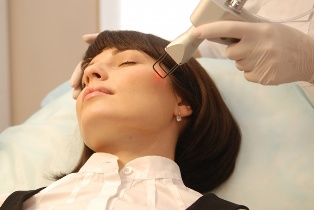
The essence of fractional laser revival
One of the latest modern developments in the field of beauty is segmented laser repair technology. Currently, it is not without reason to call it the most popular method of all laser treatment procedures.
During the session, the laser beam passing through the special fractional grating is broken down into a large number of microbeams. This method provides a point (score) effect on the skin without completely destroying the skin.
In the dermis, many smallest healing areas are formed, and the development of new young skin tissues occurs quickly. The cells around the affected area began to split densely, filling the damaged area. As a result, the process of rejuvenation is stimulated in the deep layers of the dermis. Micro-rays act on the middle and upper layers of skin tissues, helping to eliminate pigmentation, wrinkles and scars.
Partial laser repair of facial skin can help it gain firmness and elasticity. In addition, through this procedure, the pores are significantly reduced, the ellipse of the face becomes softer, the skin tone and texture are smoothed, wrinkles and scars are visibly smoothed.
4 types of segmented laser revitalization

Partial non-ablation laser rejuvenation
In the photo on the right, you can see the results of the non-ablation type fractional laser rejuvenation.
Generally, this method is used to rejuvenate the neck, face, eyelids, and remove stretch marks and acne marks.
Through this photopyrolysis, the skin will not be severely damaged. Therefore, this method is often used for lifting procedures and improving skin conditions.
The photopyrolysis method involves the use of an laser, which penetrates the epidermal layer without compromising its integrity.
In addition, a laser (1. 93 Nm) is often used. Due to the redistribution of melanin, it can more effectively remove age spots and repair hypopigmented areas.
The results of non-ablative photopyrolysis technology have been extended. For example, after four acne treatments, the skin condition improved within two years. If the purpose of photopyrolysis is to eliminate stretch marks, the result is beyond expectations: at the end of the treatment, not only the defect itself disappears, but the local tissues also gain elasticity.
After the operation, wrinkles were reduced for another three months. However, side effects were reported only in 5% of cases.
Ablative method
This technique involves the use of a CO2 laser, which penetrates into certain layers of the dermis, where the damage is formed. During this process, proteins are folded and destroyed on the surface of the skin. Three months after the operation, new collagen will form in the treated area.
This method is used for deep wrinkles, scars, hyperpigmentation, scar tissue and loose skin.
CO2 laser has a long radiation wavelength, so it can penetrate deep into the dermis and eliminate obvious defects.
In addition, a shorter wavelength laser laser is used. Its effect is very shallow, but the results will soon become visible.
Unlike non-ablation pyrolysis, patients often feel pain during and after ablation. But at the same time, compared with traditional laser ablation, this method is more effective and safer.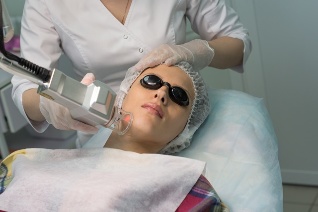
Carbon dioxide regeneration
This photo shows some changes in the laser rejuvenation program. Assume that a CO2 laser with a wavelength of 10. 6 microns is used. The light beam can clear defective cells in the epidermis in time. Due to the radiation in the tissue, intense heating of the liquid occurs. By using CO2 for partial laser repair, the evaporated water will cause structural damage in some areas, while the skin in the surrounding area maintains its integrity.
Using this method, the damaged area can be restored due to live and active cells around.
DOT repair method
This method uses a carbon dioxide laser with a wavelength of 10. 6μm. The light beam falls into the epidermal layer and selectively eliminates defective cells. As damaged and healthy areas alternate, a specific grid should be formed. As a result of the coagulation of proteins by the laser beam, harmful cells are destroyed.
Some benefits of laser revival
This technology has been used in the beauty field for more than 10 years. Compared with other anti-aging and rehabilitation therapies, it is effective, safe, and has many benefits:
Almost no side effects;
is non-invasive, so it is impossible for customers to be infected (including HIV);
easy enough;
allowed under 16 years old;
is hygienic, because the tool will not come into contact with the skin;
is suitable for tension-free skin types;
can choose a separate treatment program;
Suitable for customers with any degree of skin pigmentation;
- The defective
area is processed point by point, so the possibility of damaging the surrounding healthy tissue is ruled out;
Because the skin is only injured by 25%, the recovery period after the operation is very short (7 days for face, -14 days for body);
The effect is immediately visible after the first process;
The results obtained have been saved for several years;
can handle delicate places;
The production of elastin in the affected areas has accelerated significantly.
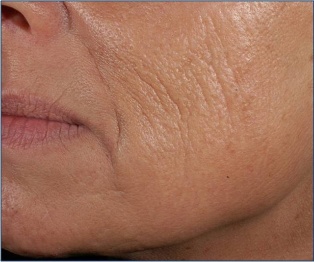
Renaissance program instructions
Part of the laser revival can be used for:
Ordinary skin rejuvenation;
Skin lifting (face, neck, shoulders, arms);
Scars and scars are smooth;
Skin alignment;
restore the contour of the face ellipse;
Wrinkle removal;
Remove age spots and melasma;
Remove stretch marks (stretch marks);
Eliminate the consequences of acne.
Intensive low-dose laser exposure may cause skin pigmentation in a short time.
In order to get good results, after this process, sunscreen cosmetics with a protection level of at least SPF 50 should be used to treat the skin.
Partial resurfacing can be compared with solid resurfacing. Judging from the wealth of foreign and domestic experience, this hardware technology is less traumatized and can greatly revitalize and tighten the effect.
Local skin rejuvenation to treat scars and stretch marks
This rejuvenation method is particularly effective in treating scar tissue. The fractional laser beam has the ability to crush rough scar tissue, after which it gains elasticity, flexibility, and the tension of the surrounding healthy tissue is reduced.
Partial photopyrolysis helps reduce the area of scars, making them elastic, unobtrusive, and as close to healthy skin as possible in appearance.
means that it can be partially rejuvenated to treat stretch marks. Unfortunately, stretch marks cannot be completely eliminated; you can only make them less visible.
The effect of local treatment is:
Reduce the area of stretch marks;
Reduce tissue fiber breakage;
Align stretch marks with healthy skin tone;
Increase the elasticity and firmness of surrounding skin tissues, and relieve tension.
This kind of rejuvenation taboo
Unlike all cosmetic surgery, it is not completely rejuvenated. Therefore, in order to avoid negative effects, it is necessary to carefully study all contraindications before the meeting.
Partial photothermal decomposition is not recommended:
During pregnancy and breastfeeding, any changes in the body of a pregnant or breastfeeding woman will affect the baby-you should not take the baby’s health risk and it is better to postpone the operation;
In the case of inflammation (or redness) in the treatment area-If the beautician’s cheek is covered by an allergic rash, the laser beautician will refuse to perform local laser photothermal decomposition (the laser beam will damage the skin to the depthsScar);
Chemical peeling-if you clean your face, you need to make the epidermis stronger for at least two weeks and prepare the laser beam;
In the presence of tumor diseases, natural complications may occur due to laser irradiation;
Diagnosed as diabetes;
In the presence of viral and bacterial infections-in order to prevent foreign elements from invading the cell structure during part of the rejuvenation process, it must first be completely restored.
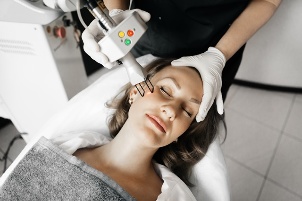
Process preparation and flow
In order to avoid the catastrophic consequences of complications after plastic surgery, you must be carefully prepared.
First, you need to consult a beautician and evaluate the condition of the facial skin. The expert will determine the list of contraindications and make the necessary recommendations.
Before this procedure, it is recommended not to go to the bathroom, sauna, solarium for 3-4 weeks. It is also prohibited to sunbathe in the sun.
Before going out, you should apply sunscreen on your face.It is very important to stop certain medications, especially antibiotics and blood thinners. In addition, doctors recommend taking anti-herpes drugs.
It is not recommended to perform operations that will damage the skin tissue no later than two weeks ago.
Part of the laser rejuvenation of the eyes and other areas requires several stages. First, the beautician must prepare the skin area for surgery. To this end, he removed decorative cosmetics, dirt, dust and sweat remaining on the skin. Then treat the surface with preservative.
The next step is to apply an anesthetic cream and leave it on the skin for about an hour.
After anesthesia, apply the contact gel evenly on the face to make the sensor slide smoothly and evenly on the skin surface.
The tip is then used to treat skin tissue in straight lines in multiple directions. The device is equipped with accessories of different sizes. Usually, 2 square centimeters of leather are processed at a time.
At the end of the process, the expert should remove the remaining contact gel and apply moisturizer.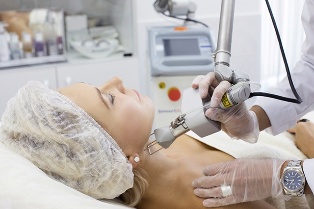
Number of sessions
After laser partial repair on part of the eyelids and other problem areas, 3-7 days of repair are required. The length of the recovery period depends on the patient's lifestyle. For example, poor living habits, malnutrition, excessive exercise, stress, and restless sleep can greatly slow down skin regeneration after surgery.
During the first three days after the treatment, redness and slight swelling of the skin may appear. Pain relievers and skin cooling products can be used to reduce discomfort.
If the skin seems taut and peels off in some places during the first week, it is considered normal. Side effects include a bronzed complexion that disappears after 14 days.
Use 2 to 5 processes to achieve lasting results. Specifically, the beautician can tell how many sessions need to be conducted based on the initial data of each case and client.
The interval between sessions should be at least 3-4 weeks. Local laser skin rejuvenation can delay aging: wrinkles are reduced or completely disappeared, skin tone increases, pores shrink, and skin tone is even. This method effectively removes pigmentation, acne, stretch marks and scars.
Possible side effects
Complications after laser relighting are very rare. In most cases, ignoring the processing instructions due to unprofessional behavior of the beautician can lead to negative consequences. Sometimes side effects occur because customers fail to follow skin care recommendations.
Most possible complication:
means skin hyperemia, self-limitation after three days;
Puffiness;
Dark skin tone;
Excessively dry and peeling skin;
burn;
Scars and scars;
White or yellow ilia hairs rise above the surface (form dense nodules under the skin);
Inflammatory process in the damaged area;
Pigmentation phenomenon (may appear due to exposure to sunlight).
If you are fully prepared before surgery, choose reliable clinics and experienced professionals, there will be no complications after small dose laser rejuvenation.

7 post-processing techniques
In order to restore your skin quickly, you must follow these suggestions:
Do not overheat the treatment area for 7 to 10 days. You can't go to the bathhouse, sauna. It is recommended not to visit the solarium for 1. 5 months.
The products prescribed by the beautician should be applied to the skin.
If the body has been treated, wear compression clothes.
Use moisturizers to treat the skin at least 2 to 3 times a day.
To carry out the regeneration process of masks containing tissue regeneration stimulants.
The shell that appears cannot be removed.
Do not peel, use scrubs and corrosive detergents.
Fractional Laser Revival Price
The price of some laser facial rejuvenation will depend on the area of the treatment area and the penetration depth of the rays. Some cosmetic clinics provide customers with price lists that indicate the cost of processing 1 square centimeter.
The cost depends on the number of sessions executed.
The best results can be obtained if the treatment is performed in a course calculated by a professional beautician.
Frequently asked questions about fractional laser rejuvenation
Minimum age allowed for laser facial rejuvenation
Almost unlimited. Treatment can be performed as early as 17 to eliminate acne scars.
This technology is particularly useful for women under 40 who want to retain their youth and charm, because the laser beam stimulates skin cells to produce collagen.
The recovery period after laser rejuvenation is usually 7-14 days. The length of recovery depends on the complexity of the problem and the type of laser exposure.
When can I start
It depends on the type of laser treatment used, the extent of the problem area, the experience and skills of the beautician. Depending on the method and the complexity of the defect, the recovery period is two days to three weeks. It happens that the patient can start working the day after the operation.
How long does it take to see the results
It takes about six months for the skin to be completely updated and become eye-catching. The result lasts for about five years
Some laser facial rejuvenation refers to efficient beauty procedures. Compared with similar anti-aging treatments, it has many advantages. But you need to know that this process is not for everyone and there are contraindications. Therefore, you must first consult an expert. To reduce the risk of complications, you should only choose reliable and proven clinics.










